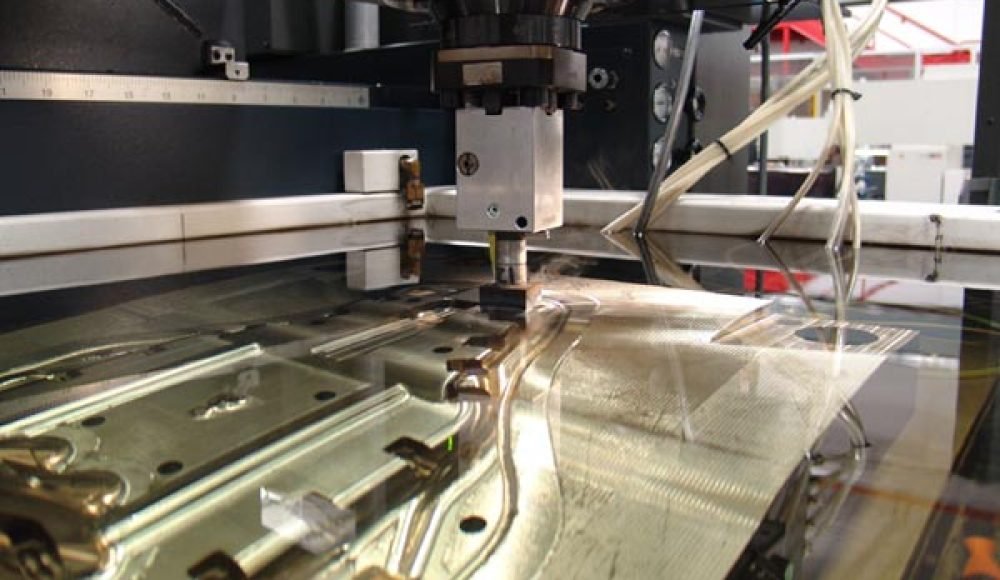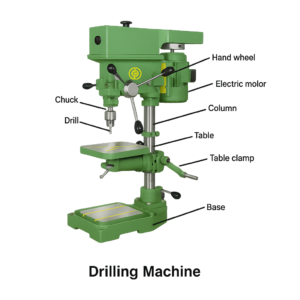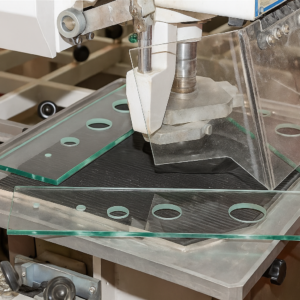En fabricación y creación de prototipos de precisión, Elegir el método de mecanizado correcto puede marcar la diferencia entre una parte funcional y un rediseño costoso. Mientras que convencional fresado CNC y torneado Excel en velocidad y versatilidad para muchas aplicaciones, Mecanizado por descarga eléctrica (electroerosión) ofrece capacidades únicas que son imposibles, o prohibitivamente caras, para lograr lo contrario. Este artículo explora siete escenarios específicos en los que EDM supera el mecanizado tradicional, Proporcionar a los ingenieros y diseñadores criterios claros para seleccionar el proceso óptimo para su próximo proyecto.
Que es edm?
Principio básico
electroerosión Elimina material a través de una serie de descargas eléctricas controladas (moscas) en lugar de cortar físico. Un electrodo conductor (ya sea una herramienta con forma o un alambre fino) se coloca justo por encima de la pieza de trabajo, ambos sumergidos en un fluido dieléctrico. Cuando se aplica un voltaje, El dieléctrico se descompone en la brecha microscópica, Generando una chispa que se derrite y vaporice una pequeña cantidad de la pieza de trabajo. El fluido dieléctrico luego elimina las partículas erosionadas.
Dos tipos principales de EDM
Plomo (Palmadita) electroerosión
Utiliza un electrodo preformado (a menudo cobre o grafito) para "sellar" cavidades 3D complejas en metales endurecidos.
Ideal para herramientas de moldeo por inyección y fundición a muerte donde se requieren características intrincadas de moho.
Electroerosión por hilo
Emplea una alimentada continuamente, latón tensado o alambre recubierto (tan delgado como 0.1 milímetros) para cortar placas gruesas.
Permite perfiles 2D precisos y agujeros de perforación en materiales de hasta varios cientos de milímetros de espesor.
Características clave de EDM
Proceso sin contacto: No hay fuerzas de corte mecánica, Eliminar virtualmente la deflexión de la herramienta y la deformación de la pieza.
Compatibilidad de material duro: Igualmente efectivo en aceros endurecidos, carburos, Superáctil, y más.
Libertad de geometría: Puede producir paredes empinadas, esquinas internas afiladas, y socavos que son imposibles con cortadores rotativos.
Siete Situaciones Donde edm Realiza betther que Mecanizado convencional
Cuando se requieren esquinas internas afiladas
Limitación de CNC: Incluso un 1 mm End Mill deja un 0.5 Radio mm en las esquinas internas.
Ventaja de cable-EDM: Con diámetros de alambre tan pequeños como 0.1 milímetros, Los radios de la esquina pueden encogerse a 0.005 ″ (0.127 milímetros).
Ejemplo de aplicación: Insertos de moho de precisión para canales microfluídicos o empaque de semiconductores.
Cuando se necesitan cavidades o agujeros muy profundos
Desafío CNC: Herramientas de relación de alta longitud a diámetro (>10:1) inducir la charla, Mal acabado superficial, y posible rotura de herramientas.
Capacidad EDM: Relaciones de profundidad a diámetro consistentes de 20:1 son rutina; proporciones hasta 100:1 se pueden lograr con configuraciones especializadas.
Caso de uso: Bolsillos de electrodo profundo en troqueles de estampado o delgados, agujeros de alta relación de aspecto en boquillas de inyector de combustible.
Al mecanizar materiales extremadamente duros
Materiales: Aceros de herramientas endurecidas (CDH 60+), carburo de tungsteno, Aleaciones de inconel, titanio, y Hastelloy.
Fuerza de EDM: La dureza del material tiene un impacto mínimo en la tasa de erosión de la chispa, permitiendo tolerancias estrechas incluso en 65 Acero RC.
Ejemplo de la industria: Ranuras de la raíz de la cuchilla de la turbina aeroespacial en Inconel 718 o rebabas de carburo de grado médico.
Cuando se desea un acabado superficial similar a un espejo
Acabado convencional: La fresación deja un "laico" direccional de marcas de herramientas; La molienda aún puede requerir pulido manual.
Aunging de acabado EDM:
De baja energía, Estrategia de paso lento: Reduce el tamaño del cráter para producir ra ≈ 0.1 micras (≈ 4 mínimo) sin post-maquinamiento.
EDM asistido por abrasivo: Agregar óxido de aluminio fino o polvo de carburo de silicio al líquido dieléctrico produce micro-pulido en proceso.
Ejemplo: Superficies de matriz para herramientas ópticas o moldes de reflector en sistemas de iluminación.
Para las luces apagadas, Producción desatendida
Estabilidad del proceso: EDM funciona con control de brecha constante y un desgaste mecánico mínimo, Reducción de la intervención.
Potencial de automatización: Los cargadores robóticos pueden cambiar de electrodos o piezas de trabajo, habilitador 24/7 Operación de "luces apagadas".
Beneficio: Maximiza la utilización del equipo para pedidos de herramientas de alto volumen durante las horas de menor actividad.
Al fabricar moldes y herramientas
Flujos de trabajo híbridos:
Maldito CNC: Retire el material a granel rápidamente.
Die Sinker EDM: Cavidades 3D y líneas de separación de complejo de máquinas.
Electroerosión por hilo: Corte los núcleos y cavidades terminados de los bloques endurecidos.
Resultado: Precisión superior en inserciones de moho y tiempos de entrega reducidos en comparación con el mecanizado CNC completo.
Cuando se necesitan tolerancias ultram-hermanas
Capacidad de tolerancia: Con múltiples pases de refinamiento, EDM logra rutinariamente ± 0.0002 ″ (± 5 µm).
Sin estrés mecánico: La ausencia de fuerzas de corte elimina el retroceso o la distorsión en las paredes delgadas.
Partes críticas: Indicadores de precisión, accesorios de metrología, y muere de alta precisión donde cada micrón cuenta.
EDM VS. Mecanizado convencional: Compensaciones clave
| Aspecto | CNC convencional | electroerosión |
| Tasa de eliminación de material | Alto | Moderado a bajo |
| Tolerancia | ± 0.001 ″ - ± 0.005 ″ | ± 0.0002 ″ |
| Acabado superficial | RA 0.8–3.2 µm típico | RA 0.1–1.0 µm alcanzable |
| Geometría | Limitado por la forma del cortador | Prácticamente cualquier forma posible |
| Costo de equipo | Más bajo por máquina | Más alto, más costo de electrodo |
| Tamaño por lotes | Flexible, pequeño a grande | Lo mejor para la creación de prototipos, volumen bajo a medio |
Pautas para elegir EDM
Evaluar la geometría de la pieza
Esquinas internas afiladas, cavidades profundas, o características finas → inclinarme hacia EDM.
Evaluar la dureza del material
Aceros endurecidos (> 60 RC), carburos, y los superalteys son los principales candidatos de EDM.
Determinar los requisitos de tolerancia
< Tolerancia ± 0.001 ″ y no se permite la tensión mecánica → EDM sobresale.
Tiempo del ciclo de equilibrio vs. Costo
Para piezas prismáticas simples de alto volumen, La fresación CNC sigue siendo más rápida y rentable.
Para complejo, de bajo volumen, o piezas de tolerancia crítica, La precisión de EDM justifica su tasa más lenta.
Optimizar los parámetros EDM
Selección de electrodos: Cobre por velocidad, Grafito para detalles finos, cables recubiertos para la calidad de la superficie.
Configuración de descarga: Utilice parámetros de desacuerdo para la eliminación a granel, Luego cambie a la configuración de finalización para superficies de espejo.
Gestión dieléctrica: Mantener la pureza y la temperatura de los líquidos para garantizar un comportamiento constante de chispa.
Conclusión & Siguientes pasos
El mecanizado de descarga eléctrica une la brecha entre las limitaciones de la herramienta de corte y las ambiciones de diseño. Aprovechando la erosión de la chispa, EDM habilita:
Afilado, esquinas internas cuadradas con submarino-0.005″ Radios
Profundo, Cavidades de alta relación de aspecto libre de charla
Mecanizado de precisión de las aleaciones de ingeniería más duras
Superficies de calidad de espejo sin pulido manual
No tripulado, Producción continua para mejorar el rendimiento
Tolerancias ultra altos a ± 5 µm
Cuando su diseño exige geometría, dureza, o precisión más allá del alcance de la fresación de CNC, Integre EDM en su flujo de trabajo. Durante la fase de diseño, Características de la bandera como esquinas agudas, ranuras profundas, o dimensiones críticas y consultar con un especialista en EDM. Para un estudio de factibilidad detallado y una cita gratuita de maquinamiento de precisión, Póngase en contacto con los expertos en Tops Precision o su proveedor de EDM de confianza hoy.
Leer más
Consejos de diseño de fundición de die
Servicios de mecanizado CNC de precisión



